
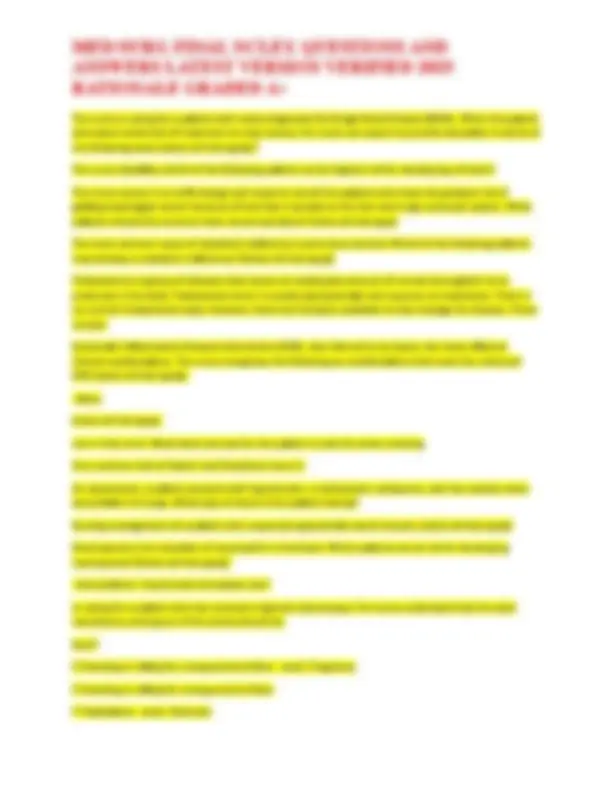
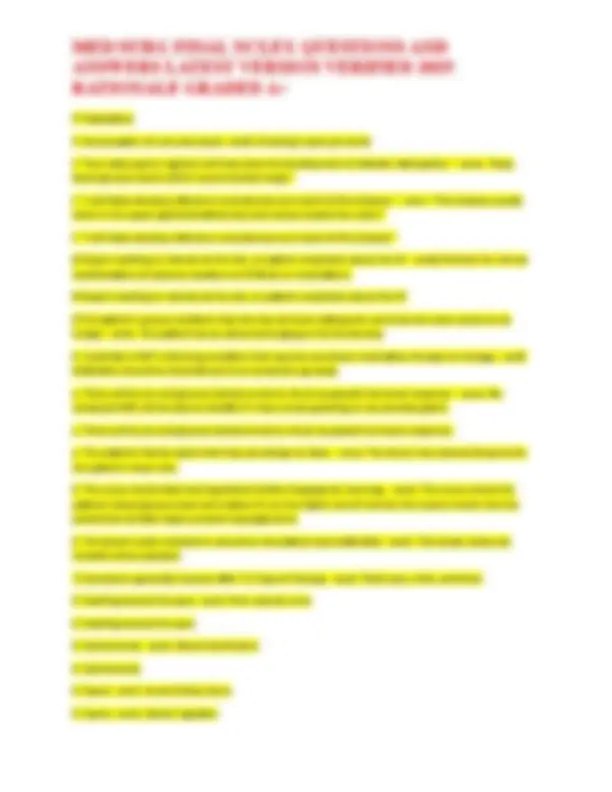
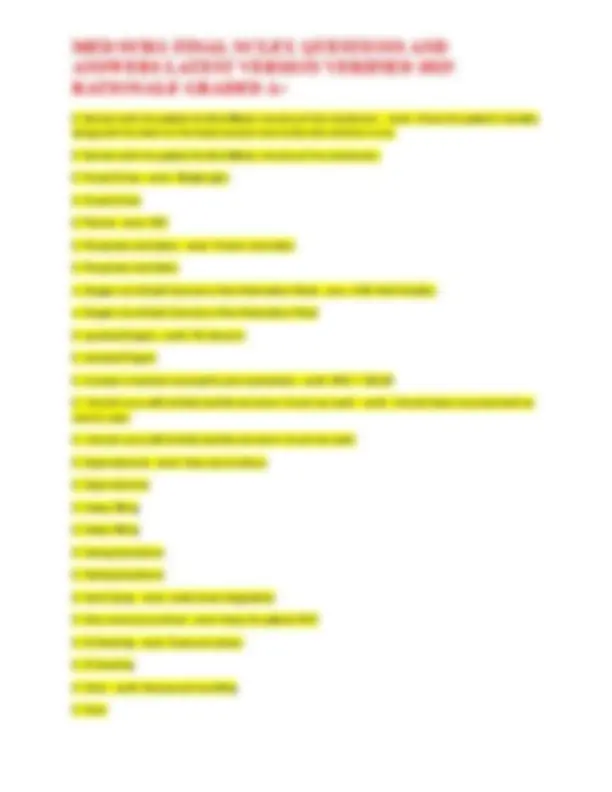
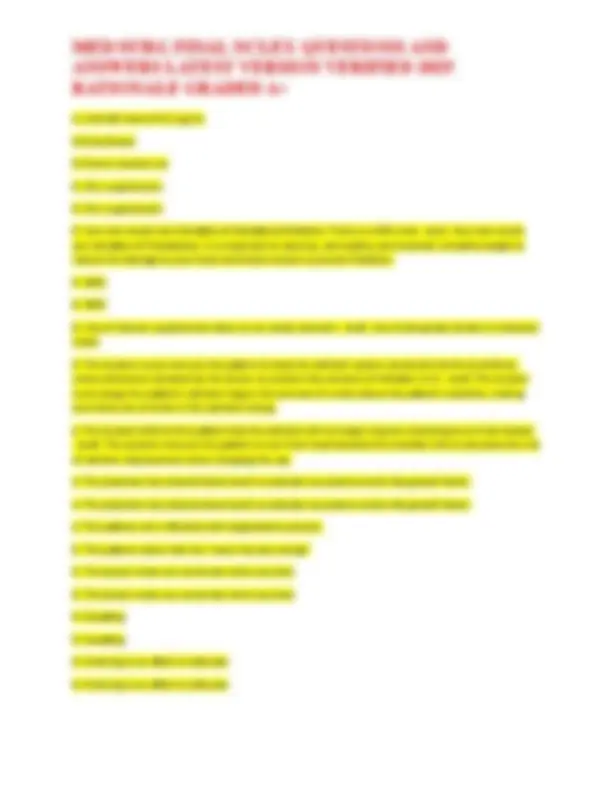
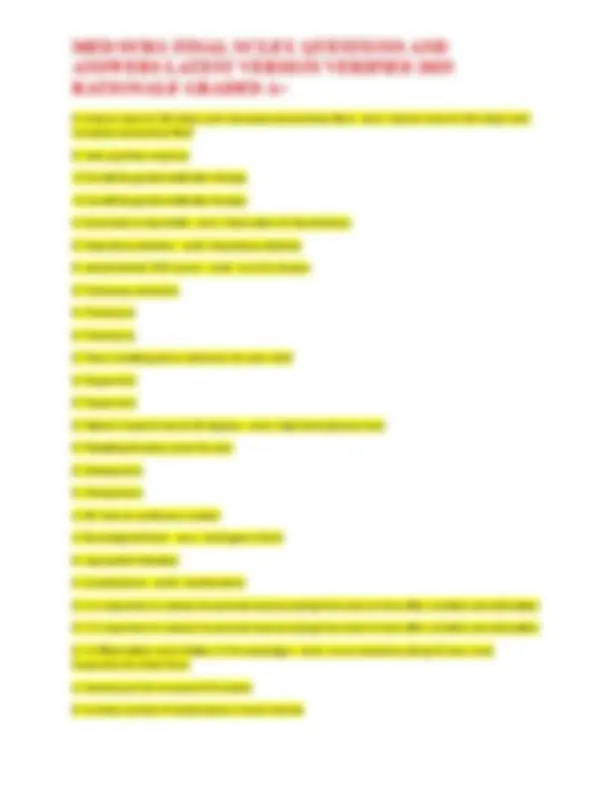
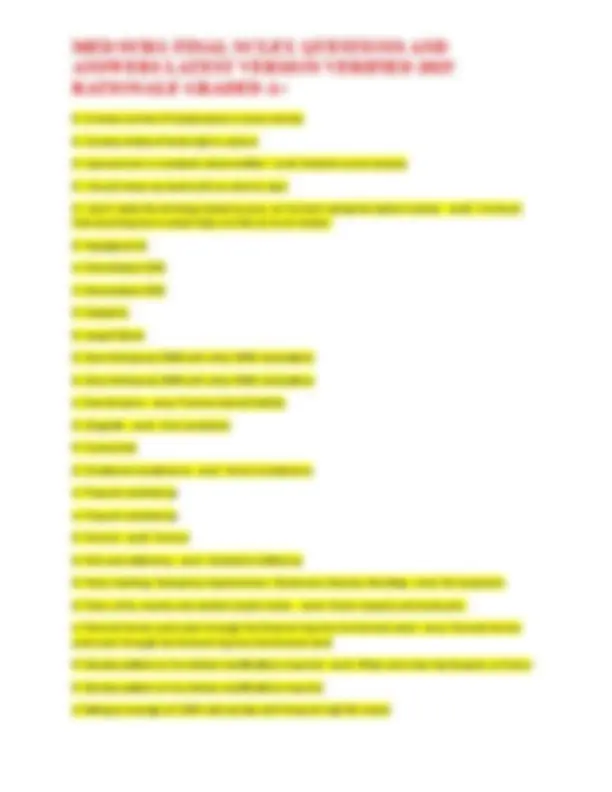
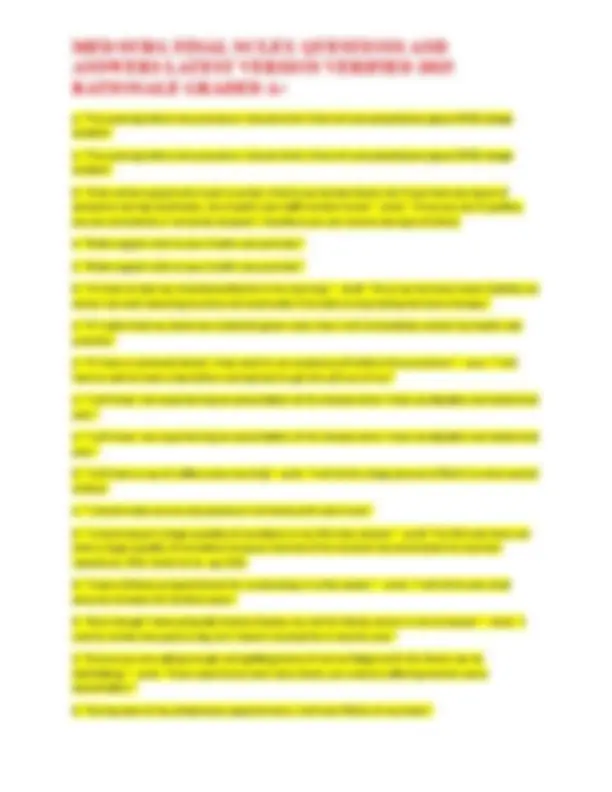
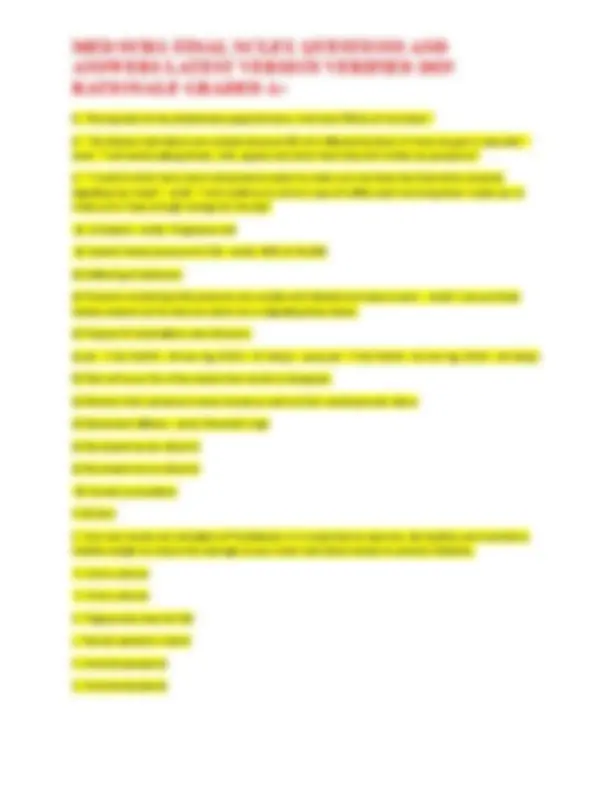
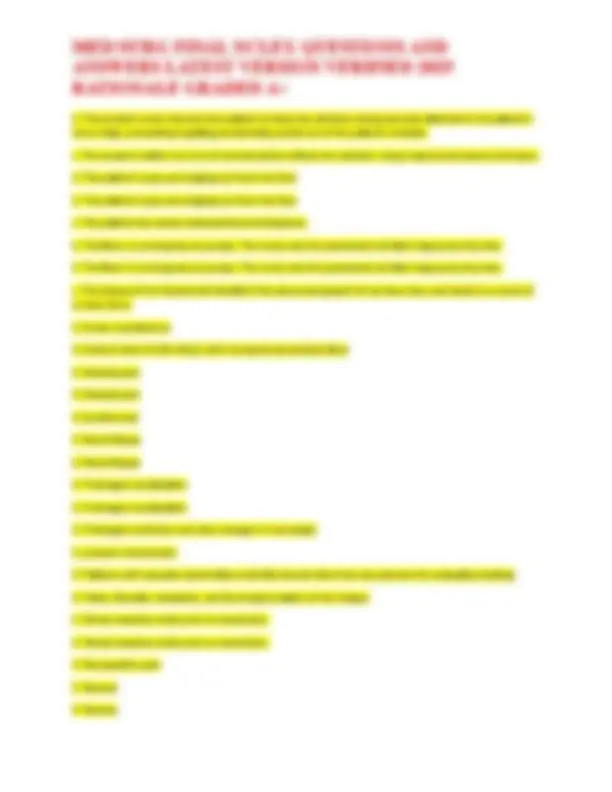
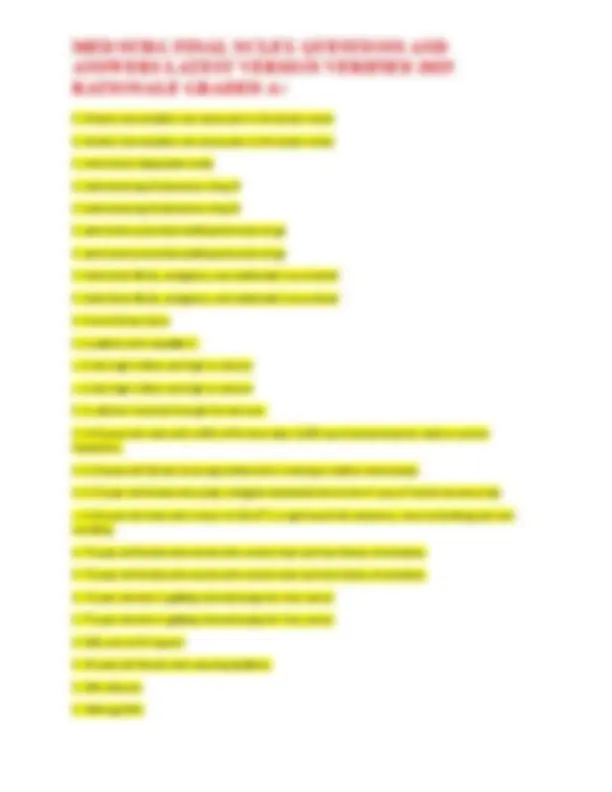
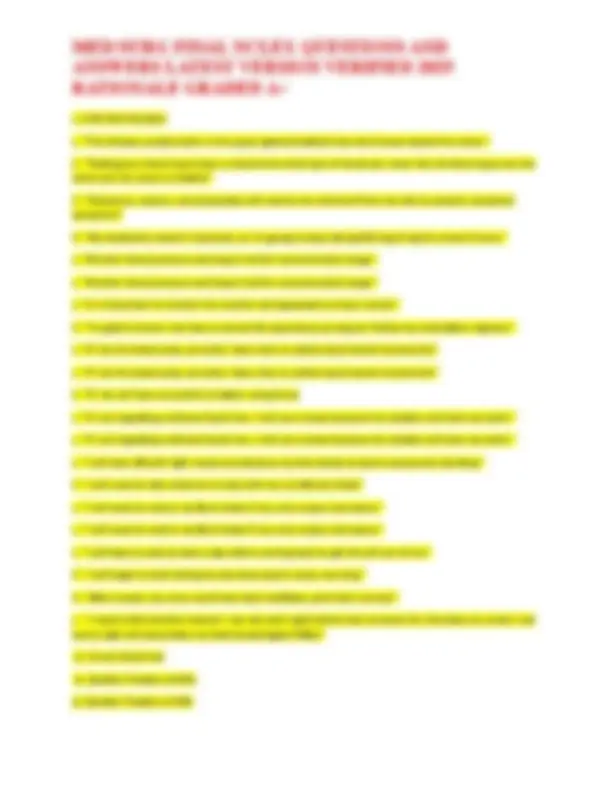
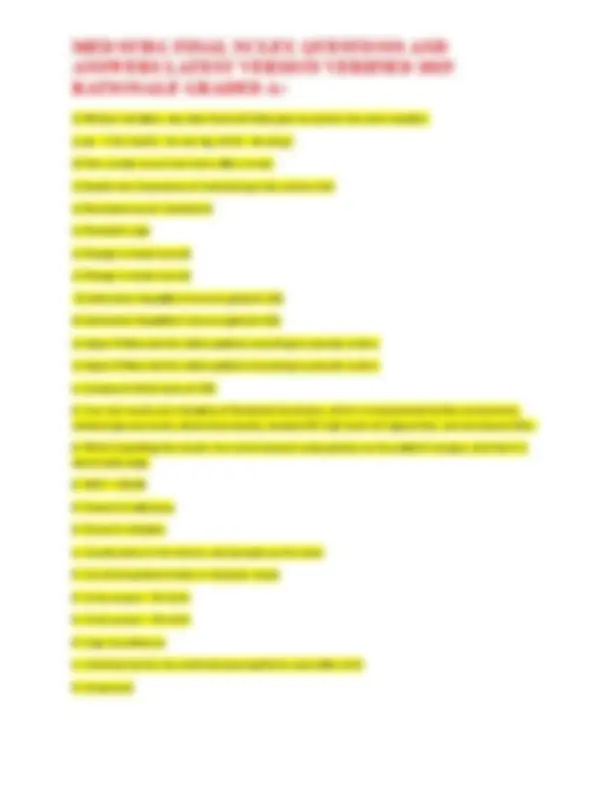
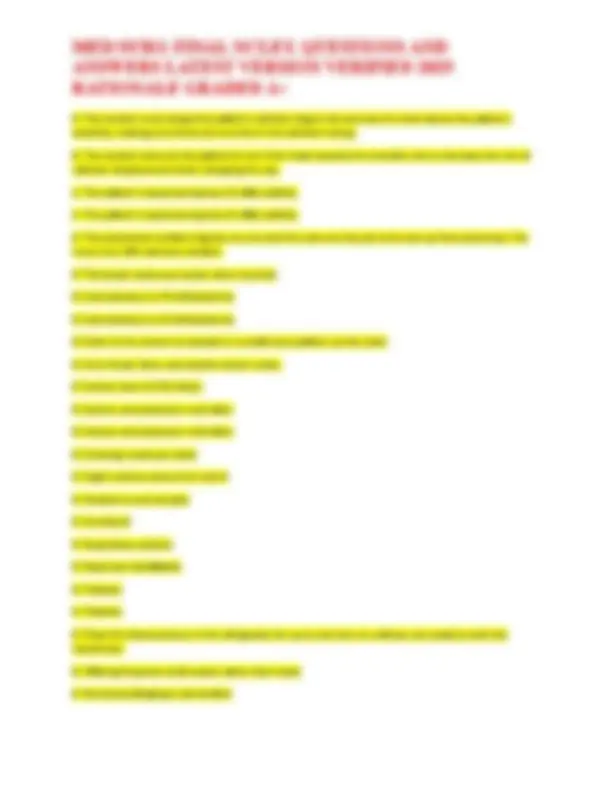
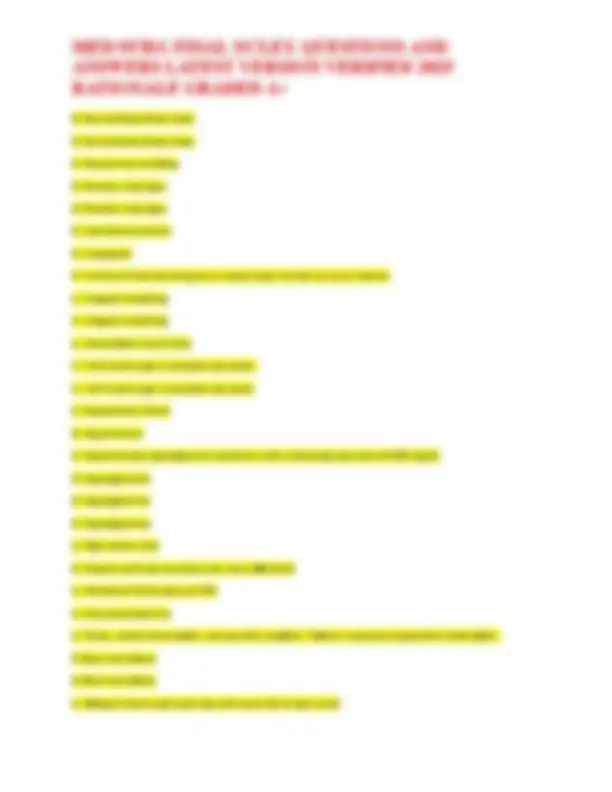
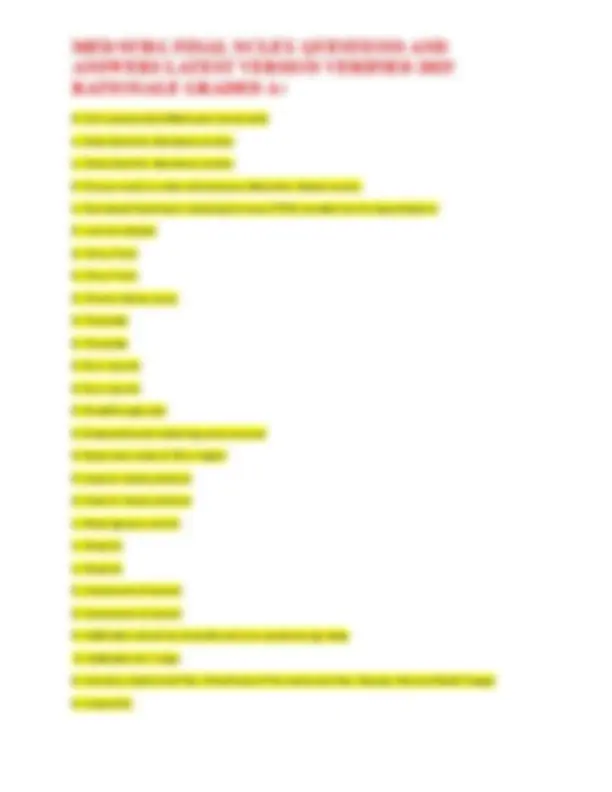
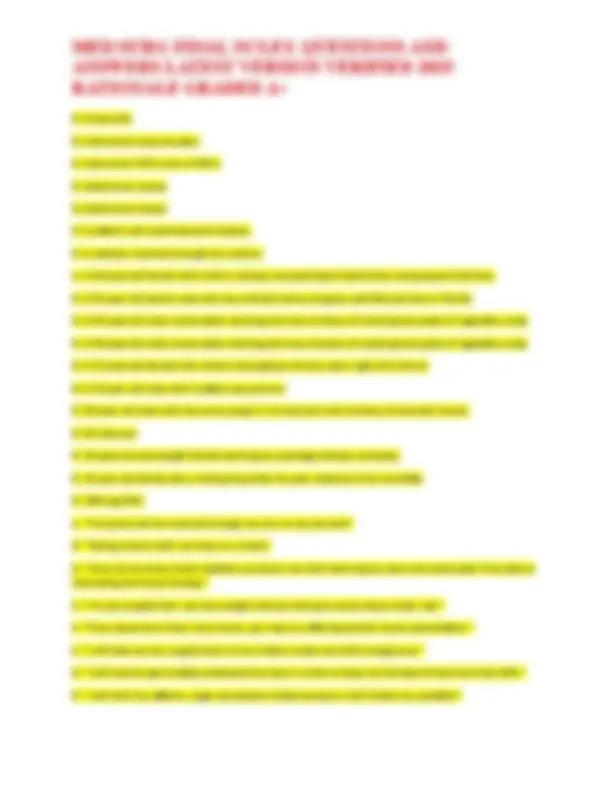
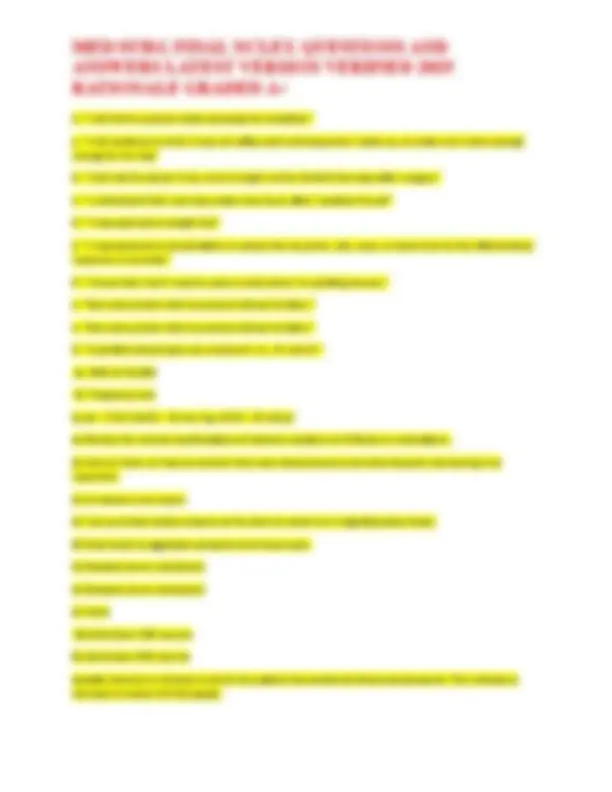
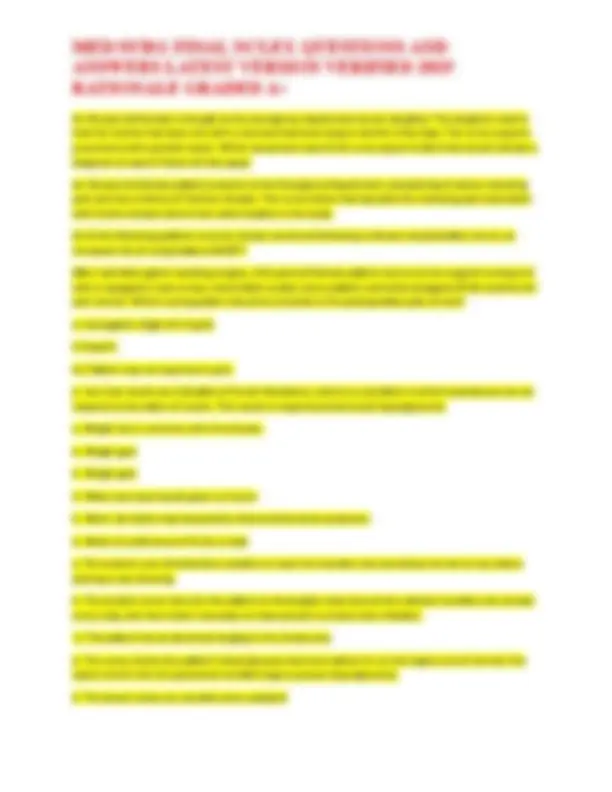
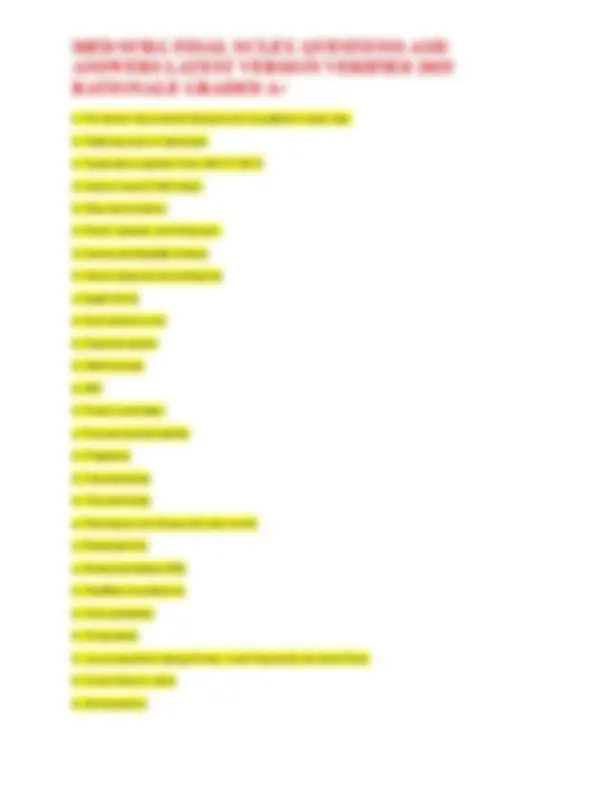
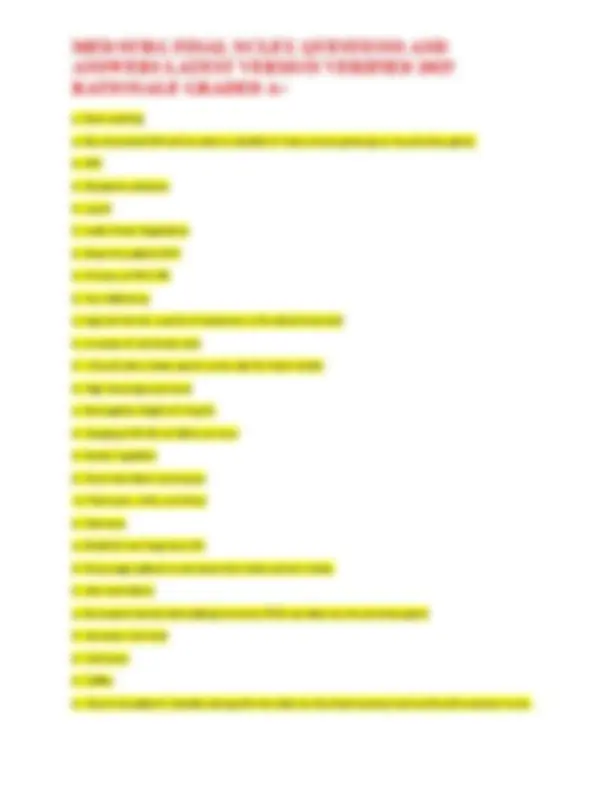
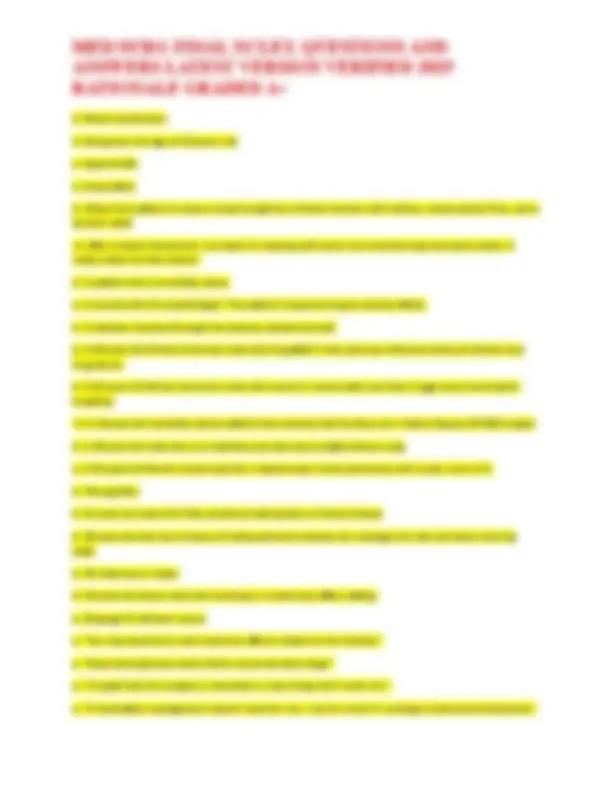
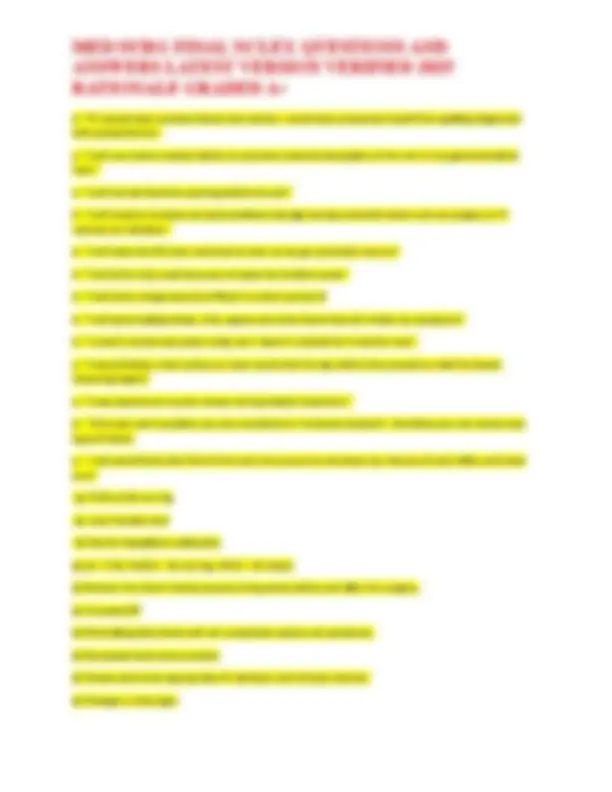
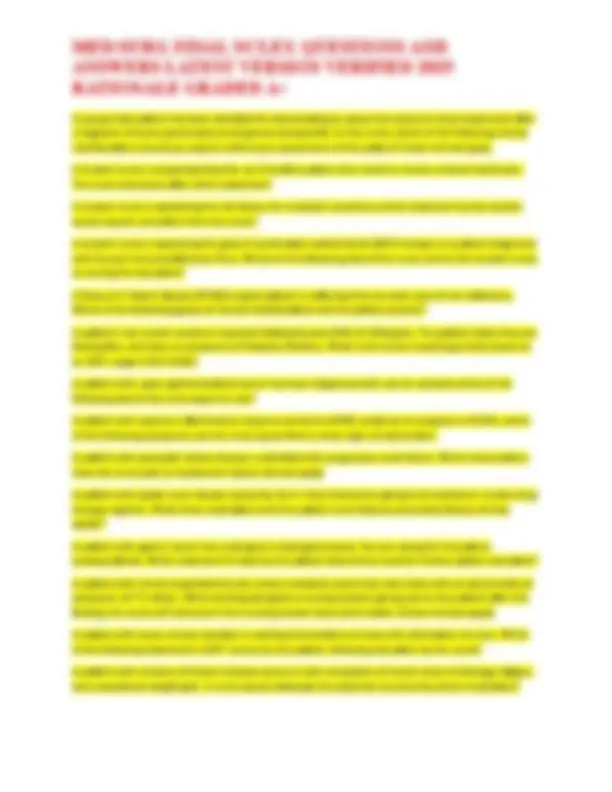
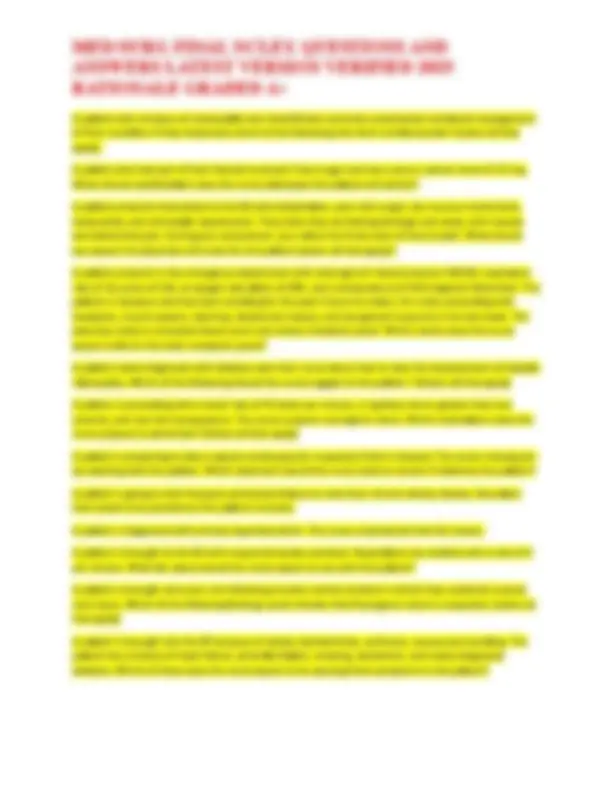
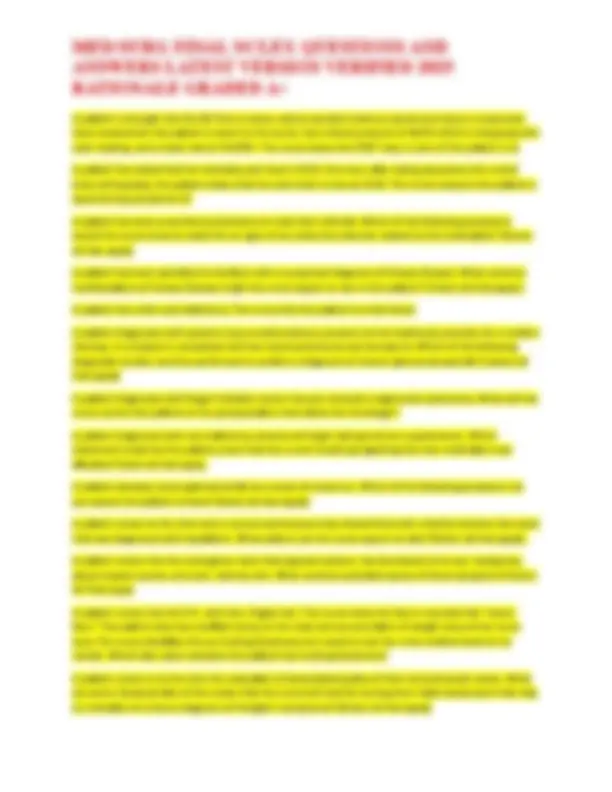
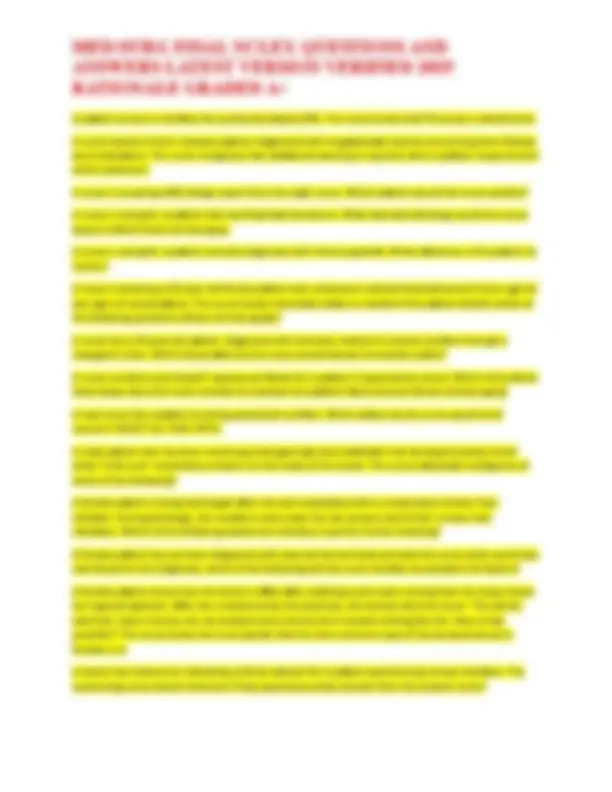
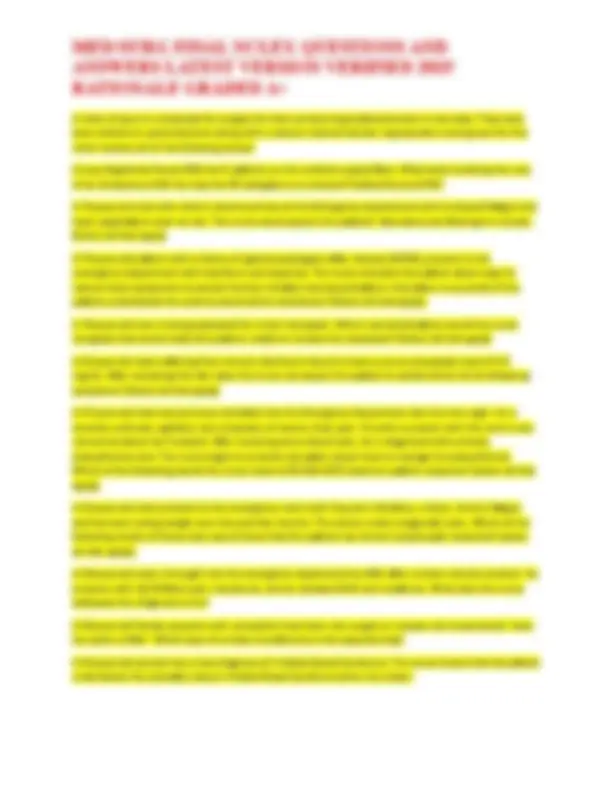
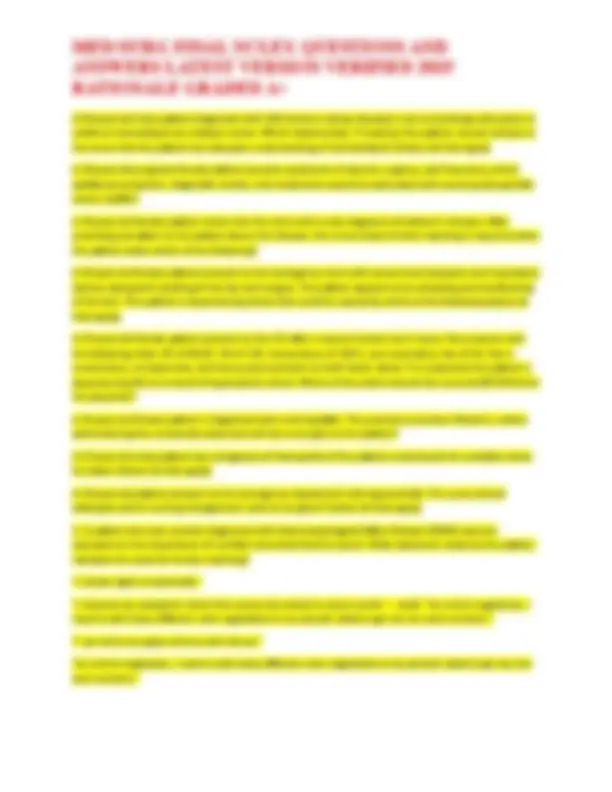













Study with the several resources on Docsity

Earn points by helping other students or get them with a premium plan


Prepare for your exams
Study with the several resources on Docsity

Earn points to download
Earn points by helping other students or get them with a premium plan
Community
Ask the community for help and clear up your study doubts
Discover the best universities in your country according to Docsity users
Free resources
Download our free guides on studying techniques, anxiety management strategies, and thesis advice from Docsity tutors
MED SURG FINAL NCLEX QUESTIONS AND ANSWERS LATEST VERSION 2025 VERIFIED RATIONALE GRADED A+.pdf
Typology: Exams
1 / 47

This page cannot be seen from the preview
Don't miss anything!








































Your 52-year-old male patient has gone into septic shock. What emergency management care do you anticipate doing? You would include all of the following in a discharge plan for a patient with Chronic Kidney Disease EXCEPT: You are discussing the diagnostic procedures that have been ordered by the physician with a client who is suspected of having acromegaly. Which of the following statements by the client would indicate that they understand the current plan? (Select all that apply) While providing discharge teaching for a patient who had an adjustable gastric band placed, which statement if made by the patient would indicate the need for further teaching? While providing care to a patient that has a suspected intestinal obstruction, the nurse should be assessing closely for deterioration of the patient's condition. The nurse would expect these to include which of the following: While being given change of shift report, the night nurse informs you that a patient receiving Parenteral Nutrition had the infusion rate increased two hours ago to catch up to the ordered amount. During your initial shift assessment of the patient, you note jugular vein distention, crackles in bilateral lung bases, bounding pulses and blood pressure of 190/98. Which potential complication of Parenteral Nutrition is the patient most likely experiencing? Which patient is most at risk for developing a urinary tract infection? Which patient is at the highest risk for developing a Uric Acid Urinary Calculi? Which of these statements is true about Crohn's disease? Select all that apply: Which of the following symptoms would be indicative of a ureterovesical junction (UVJ) urinary stone (Select all that apply)? Which of the following is NOT used to treat diabetic neuropathy? Which of the following individuals would most likely develop a hiatal hernia? Which of the following characteristics correctly describes manifestations of multiple myeloma? Select all that apply. When providing discharge instructions to a patient who just had a Route-en-Y Gastric Bypass (RYGB) surgery it is important to mention that they should not consume sugary foods or else they may experience which of the following symptoms? (Select all that apply) When providing discharge instructions to a patient newly diagnosed with sickle cell disease, it is important to mention that they should seek early medical attention for upper respiratory infections or else they may experience which of the following symptoms?
When performing client education for a patient recently diagnosed with lactase deficiency, the nurse knows that the teaching was effective when the patient repeats the following to her. Tina is a 70-year-old female from Austin, Texas who works at her favorite restaurant, Kentucky Fried Chicken (KFC) part time. During her annual physical, she claims to only smoke one pack of cigarettes per week and drinks a glass of wine with dinner. She stated that she became a vegetarian for her New Year's resolution one year ago. She was diagnosed with lymphoma 3 years ago and has recently stopped with treatments. Her favorite snacks are nuts and seeds. What are her risk factors for developing Diverticulitis, which is "inflammation of one or more diverticula, resulting in perforation into the peritoneum?" Select all that apply: time" The physician orders an arterial blood gas who is hyperventilating. The nurse can anticipate that the blood gas results will most likely reveal that the patient is in: The physician has ordered one unit of packed red blood cells to be infused over two hours for a patient in sickle cell crisis. Which of the following are appropriate steps for the nurse to take to ensure the order is performed safely? (Select all that apply). The patient is experiencing the following symptoms: shakiness, palpitations, nervousness, diaphoresis, anxiety, hunger, pallor, difficulty speaking, visual disturbances, stupor, and confusion. As a nurse, you anticipate which treatment to be prescribed? (multiple choice). The nursing student is doing discharge teaching for a patient who was admitted for an acute exacerbation of ulcerative colitis. The nurse intervenes if the student makes which of the following statements? The nurse is teaching a patient with chronic kidney disease about necessary nutritional changes. The nurse knows to include which of the following: (Select all that apply) The nurse is teaching a patient newly diagnosed with ulcerative colitis about characteristics of the disease. The nurse determines further teaching is necessary if the patient makes which of the following statement(s)? Select all that apply. The nurse is teaching a patient about effective ways to prevent kidney cancer. The nurse knows the patient understands the teaching when the patient makes which statement? The nurse is providing patient education to a client diagnosed with bacterial urethritis. The patient should be provided with all of the following information EXCEPT (select all that apply): The nurse is observing a student who is performing CVAD (central venous access device) care on a patient. Which action, if made by the student, would indicate that further instruction is necessary? The nurse is completing patient teaching for how to prep the bowel for a colonoscopy to evaluate for polyps. The nurse knows teaching has been effective when the patient states (select all that apply).
F. Palpitations F. Consumption of nuts and seeds - ansB. Smoking 1 pack per week f. "Your daily aspirin regimen will help slow the development of diabetic retinopathy." - ansa. "Keep blood glucose levels within recommended range." f. "I will likely develop a fistula or anal abscess as a result of this disease." - ansc. "This disease usually starts in the upper gastrointestinal tract and moves toward the colon." f. "I will likely develop a fistula or anal abscess as a result of this disease." f) Report swelling or redness at the site, or patient complaints about the IV. - ansb) Monitor for clinical manifestations of adverse reactions to IV fluids or medications. f) Report swelling or redness at the site, or patient complaints about the IV. E.The patient's spouse mentions that she has not been eating well, and that she never seems to be hungry - ansA. The patient has an abnormal bulging in the throat area E. Urethritis is NOT a life-long condition that requires consistent medication therapy to manage - ansB. Antibiotics should be discontinued once symptoms go away e. There will be an oral glucose tolerance test to check my growth hormone response. - ansa. My scheduled MRI will be able to identify if I have a mass growing on my pituitary gland. e. There will be an oral glucose tolerance test to check my growth hormone response. e. The patient's family states that they are allergic to latex. - ansa. The doctor has ordered Atropine for the patient's heart rate. E. The nurse checks label and ingredients before hanging the new bag. - ansA. The nurse checks the patient's blood glucose level and notices it's on the higher end of normal. She injects insulin into the parenteral nutrition bag to prevent hyperglycemia. E. The lymph nodes subsided in size when the patient took antibiotics - ansA. The lymph nodes are movable when palpated E. Symptoms generally improve after 1-2 days of therapy - ansA. Flank pain, chills, and fever E. Swelling around the eyes - ansA. Rust colored urine E. Swelling around the eyes E. Splenectomy - ansA. Blood transfusions E. Splenectomy E. Sepsis - ansC. Acute kidney injury E. Sepsis - ansA. foods/ ingestion
E. Remain with the patient for first fifteen minutes of the transfusion. - ansA. Check the patient's identity along with the label on the blood product and verify with another nurse. E. Remain with the patient for first fifteen minutes of the transfusion. E. Purple Striae - ansA. Weight gain E. Purple Striae E. Plasma - ansA. RBC E. Phosphate restriction - ansA. Protein restriction E. Phosphate restriction e. Oxygen via a Nasal Cannula or Non-Rebreather Mask - ansc. 0.9% NaCl Solution e. Oxygen via a Nasal Cannula or Non-Rebreather Mask E. Lactated Ringers - ansB. 5% Albumin E. Lactated Ringers E. increase in banded neutrophils and myeloblasts - ansB. WBC > 100, E. I should use a soft bristled toothbrush when I brush my teeth - ansD. I should shave my beard with an electric razor E. I should use a soft bristled toothbrush when I brush my teeth E. Hypercalcemia - ansA. Slow and insidious E. Hypercalcemia E. Heavy lifting E. Heavy lifting E. Having lymphoma E. Having lymphoma E. Hard Candy - ansA. Leafy Green Vegetables E. Give enema as ordered - ansA. Keep the patient NPO E. GI bleeding - ansA. Ruptured spleen E. GI bleeding E. Fever - ansB. Nausea and vomiting E. Fever
E. A 28-year-old female nursing student taking Pepcid and Omeprazole to control a Pepcid ulcer for the past three years E. 20-year-old male who has an abrupt sore throat. His mom smokes but he has never tried alcohol. He lives a healthy lifestyle but is worried about second hand smoke. - ansB. 69-year old male who has some polyps in his stomach and a history of stomach cancer. E. 112mcg/24hr - ansC. 140mcg/24hr e. "This treatment will require blood transfusions to be effective." - ansa. "I may experience muscle cramps during dialysis treatment." e. "Laser photocoagulation treatment may help slow progression of diabetic retinopathy." e. "Laser photocoagulation treatment may help slow progression of diabetic retinopathy." E. "If my feet and hands begin to turn bright red, I will need to contact my physician immediately." E. "If my feet and hands begin to turn bright red, I - ansA. "If I would have received blood tests earlier, I could have prevented myself from getting diagnosed with polycythemia." e. "I will know I'm ready for the procedure when I have normal bowel movements" - ansa. "I should follow a low residue diet the day before the procedure until the bowel cleansing begins" e. "I may experience constipation, so I will include high-fiber foods in my diet, drink 3 liters of water every day, and use stool softeners as needed." - ansb. "I will take my iron supplements 1 hour before meals and with orange juice." e. "I may experience constipation, so I will include high-fiber foods in my diet, drink 3 liters of water every day, and use stool softeners as needed." e. "I have been diagnosed with an autoimmune disease." E) There are no common traits between gastric and duodenal ulcers. - ansa. Patient may not experience pain. e) Evaluate patient for clinical manifestations of fluid overload or hypovolemia and initiate appropriate changes in IV fluids. e) Elevated BUN - ansa) Decreased total serum protein E) Educate the patient on the need for annual follow-ups - ansA) Test for Hepatitis A antibodies e) Change in patient's pain - ansa) Changes in vital signs e) Change in patient's pain e) Assure the client that they will be able to live a full life following the removal of only one of their kidneys. - anse) Assure the client that they will be able to live a full life following the removal of only one of their kidneys.
d: a ferritin level of 8.2 ng/mL D.Dried Beans D.Chronic alcohol use D. Zinc supplements D. Zinc supplements D. Your test results are indicative of Gestational Diabetes. There is a 63% chan - ansC. Your test results are indicative of Prediabetes. It is important to exercise, eat healthy, and maintain a healthy weight to reduce the damage to your heart and blood vessels to prevent Diabetes. D. WBC D. WBC D. Use of Calcium supplements taken on an empty stomach - ansB. Use of phosphate binders in between meals D. The student nurse instructs the patient to keep the catheter system closed and sterile at all times, unless otherwise indicated by the doctor, to prevent the entrance of infection in th - ansB. The student nurse hangs the patient's catheter bag on the armrest of a chair above the patient's waistline, making sure there are no kinks in the catheter tubing. d. The student informs the patient that the catheter will no longer require a dressing once it has healed.
D. increase number of lymphocytes in bone marrow D. Increase intake of foods high in sodium D. Improvement in metabolic abnormalities - ansB. Skeletal muscle atrophy D. I should shave my beard with an electric razor D. I don't really like drinking cranberry juice, so I've been taking the tablets instead. - ansB. I've found that douching once a week helps me feel so much cleaner. D. Hypoglycemia d. Hemodialysis (HD) d. Hemodialysis (HD) D. Headache D. hang IV fluids D. Gives Veltassa at 0900 with other 0900 medications D. Gives Veltassa at 0900 with other 0900 medications d. Give Atropine - ansa. Promote Spinal Stability D. Gingivitis - ansA. Oral candidiasis D. Furosemide D. Functional incontinence - ansC. Stress incontinence d. Frequent swallowing d. Frequent swallowing D. Formed - ansD. Formed D. Folic acid deficiency - ansC. Cobalamin deficiency D. Fever, Swelling, Tachypnea, Hypertension, Tenderness, Nausea, Vomiting - ansA. No Symptoms D. Fever, chills, nausea, and swollen lymph nodes. - ansA. Shock, hypoxia, and body pain. d. Femoral hernia: protrusion through the femoral ring into the femoral canal - ansd. Femoral hernia: protrusion through the femoral ring into the femoral canal D. Educate patient on the dietary modifications required - ansA. Water and clear liquids given q 2 hours D. Educate patient on the dietary modifications required d. Eating an average of 3,000 calories/day with frequent high-fat snacks
D. Dried Beans D. CT Scan D. CT Scan d. Clindamycin D. Chronic pain - ansB. Breakthrough pain D. Chronic alcohol use D. Cardiac dysrhythmias D. Cardiac dysrhythmias D. Bowel obstruction D. Bowel obstruction D. Blood Glucose of 168 - ansC. Triglycerides level of 130 D. Being a vegetarian D. Aseptic technique is not required with peritoneal dialysis. - ansC. Encourage patient to increase their dietary protein intake. d. Antiseizure medications, tricyclic antidepressants, Selective Serotonin Reuptake Inhibitors and Selective Norepinephrine Reuptake Inhibitors. - ansa. Amputation D. Anemia D. Anemia d. An order to check the blood glucose and give 4-6 ounces of fruit juice if the reading is less than 70 mg/dL. The patient is experiencing hypoglycemia. - ansd. An order to check the blood glucose and give 4- 6 ounces of fruit juice if the reading is less than 70 mg/dL. The patient is experiencing hypoglycemia. D. All of the above - ansA. Testicular pain or labial pain d. Alcohol poisoning and hyperkalemia - ansc. Hypomagnesemia and digitalis toxicity D. Air embolism - ansC. Hypervolemia D. Administer STAT oral anticoagulants - ansD. Administer STAT oral anticoagulants D. Administer blood products along with lactated Ringer's solution. d. Administer antibiotics right away - ansa. Establish two large bore IVs D. A patient who smokes. - ansC. A patient with hepatitis C.
d. "The evening before the procedure I should drink 2 liters of oral polyethylene glycol (PEG) lavage solution" d. "The evening before the procedure I should drink 2 liters of oral polyethylene glycol (PEG) lavage solution" D. "Only certain people who meet a certain criteria can donate blood, but if you have any types of symptoms during transfusion, let a health care staff member know" - ansA. " Since you are A positive, you are considered a "universal recipient", therefore you can receive any type of blood. d. "Make regular visits to your health care provider." d. "Make regular visits to your health care provider." D. "It's best to take my mineralocorticoids in the morning." - ansB. "Once my hormone levels stabilize my doctor can start lowering my dose and eventually I'll be able to stop taking hormone therapy." d. "If I notice that my stools are a blackish-green color, then I will immediately contact my health care provider." d. "If I have a narrowed bowel, I may need to use a patency pill before this procedure." - ansc. "I will have to wait at least a day before coming back to get this pill out of me." d. "I will know I am experiencing an exacerbation of the disease when I have constipation and abdominal pain." d. "I will know I am experiencing an exacerbation of the disease when I have constipation and abdominal pain." D. "I will have a cup of coffee every morning" - ansA. "I will drink a large amount of fluid in a short period of time" d. "I should make sure to eat potassium rich foods with each meal." D. "I should expect a large quantity of secretions in my NG tube canister" - ansD. The NG tube does not drain a large quantity of secretions because removal of the stomach has eliminated the reservoir capacity (p. 921). (Lewis et al., pg. 921). D. "I have a follow-up appointment for a cystoscopy in a few weeks." - ansA. "I will drink only small amounts of water for the first week." D. "Even though I have polycystic kidney disease, my risk for kidney cancer is not increased." - ansA. "I used to smoke two packs a day, but I haven't smoked for 6 months now." d. "Ensure you are eating enough and getting plenty of rest as fatigue with this illness can be debilitating." - ansb. "If you experience hard, tarry stools, you may be suffering another acute exacerbation." D. "During each of my phlebotomy appointments, I will lose 700mL of my blood."
D. "During each of my phlebotomy appointments, I will lose 700mL of my blood." D. " No dietary restrictions are needed because IBS isn't effected by food, it's how my gut is naturally" - ansA. "I will avoid eating wheat, milk, apples and other food that will irritate my symptoms" d. " I need to drink more room temperature water to make sure my body has help when properly digesting my meals" - ansB. "I will continue to drink 2 cups of coffee each morning when I wake up, to make sure I have enough energy for the day" d). Urinalysis - ansb). Pregnancy test d). Systolic blood pressure of 110 - ansb). WBC of 16, d) Softening of abdomen d) Products containing milk products are usually well labeled and easy to spot. - ansb) I can purchase lactase enzyme at the store to assist me in digesting dairy foods. d) Prepare IV medications and infusions. d) pH - 7.24, PaCO2 - 39 mm Hg, HCO3 - 17 mEq/L - ansc) pH - 7.29, PaCO2 - 52 mm Hg, HCO3 - 24 mEq/L D) Pain will occur for a few weeks then tends to disappear. d) Monitor their potassium levels closely as well as their cardiovascular status d) Depressed reflexes - ansc) Chvostek's sign d) Decreased serum albumin d) Decreased serum albumin D) Contact precautions C.Chicken C. Your test results are indicative of Prediabetes. It is important to exercise, eat healthy, and maintain a healthy weight to reduce the damage to your heart and blood vessels to prevent Diabetes. C. Urine cultures C. Urine cultures C. Triglycerides level of 130 c. Topical capsaicin creams C. thrombocytopenia C. thrombocytopenia
C. Muscle weakness C. Muscle weakness C. Metoprolol C. Metabolic acidosis C. Lower quadrant pain C. Lower quadrant pain C. Is considered inflammation of the mucosa of the stomach C. Iron supplements c. Involves the entire thickness of the bowel wall c. Involves the entire thickness of the bowel wall c. Insert an indwelling bladder catheter c. Insert an indwelling bladder catheter C. Increase intake of fluids by 200% C. Increase immune function c. Incisional hernia: weakness at the site of a previous incision C. Identify health information concerning CPAP devices C. I make sure to go to the restroom 4 times during my twelve hour shift, even if I don't need to go. C. I am due for my flu shot C. Hyponatremia, hyperkalemia, and dehydration. c. Hypomagnesemia and digitalis toxicity C. Hypocellular bone marrow C. Hypocellular bone marrow C. Hypervolemia c. Hoarseness c. High potassium diet C. Herpes C. Heart rate > 100 bpm
C. Heart rate > 100 bpm c. Give IV Normal Saline C. Gastric residual volume 400mL c. Furosemide C. Food additives C. Flank pain C. Flank pain C. environmental agents C. environmental agents C. Encourage patient to increase their dietary protein intake. C. Education on symptoms of electrolyte imbalance C. Edema C. Drinking 1 glass of wine daily C. Diarrhea and abdominal cramps C. Diarrhea and abdominal cramps c. Destruction of thyroid tissue C. Cobalamin deficiency C. Clarithromycin C. Clarithromycin c. Cardiogenic Shock C. Cancer in the lungs C. Cancer in the lungs C. Avocados c. An Red Blood Cell count of 4,500,000/L c. An order to check the blood glucose and immediately administer insulin intravenously if the reading is greater than 250 mg/dL. The patient is experiencing diabetic ketoacidosis. C. An obese 75 year old woman who lives in an assisted living home and suffers from dementia and incontinence.
c. 0.9% NaCl Solution c. "This disease usually starts in the upper gastrointestinal tract and moves toward the colon." C. "Testing your blood type helps us determine what type of blood you need. Not all blood types are the same and can cause a reaction" C. "Potassium, sodium, and phosphate will need to be restricted from my diet to prevent unwanted symptoms" C. "My headaches haven't improved, so I'm going to keep taking 800 mg of aspirin every 4 hours." c. "Monitor blood pressure and keep it within recommended range." c. "Monitor blood pressure and keep it within recommended range." c. "It is important to monitor the number and appearance of your stools." C. "I'm glad to know I can have a normal life expectancy as long as I follow my medication regimen." c. "If I do the bowel prep correctly I have clear or yellow liquid bowel movements" c. "If I do the bowel prep correctly I have clear or yellow liquid bowel movements" C. "If I do not have successful urination using these c. "If I am ingesting undiluted liquid iron, I will use a straw because the solution will stain my teeth." c. "If I am ingesting undiluted liquid iron, I will use a straw because the solution will stain my teeth." c. "I will start off with light meals and advance my diet slowly to avoid nausea and vomiting." C. "I will need to take vitamins to help with my nutritional intake" c. "I will need to restrict my fluid intake if my urine output decreases." c. "I will need to restrict my fluid intake if my urine output decreases." c. "I will have to wait at least a day before coming back to get this pill out of me." C. "I will begin to start taking my low dose aspirin every morning." C. "After a week, my urine could have dark red flakes, and that's normal." c. " I need to find another dessert I can eat each night before bed, because the chocolate ice cream I eat every night will exacerbate my Gastroesophageal Reflux" c). Occult blood test c). Ejection Fraction of 40% c). Ejection Fraction of 40%
c) Without variation, any dairy food will likely give my system the same reaction. c) pH - 7.29, PaCO2 - 52 mm Hg, HCO3 - 24 mEq/L C) Pain usually occurs two hours after a meal. c) Explain the importance of maintaining a low sodium diet c) Decreased serum cholesterol c) Chvostek's sign c) Change in bowel sounds c) Change in bowel sounds C) Administer Hepatitis A immune globulin (IG) C) Administer Hepatitis A immune globulin (IG) c) Adjust IV flow rate for stable patients according to provider orders. c) Adjust IV flow rate for stable patients according to provider orders. b: hematocrit (Hct) value of 32% B. Your test results are indicative of Metabolic Syndrome, which is characterized by five components: elevated glucose levels, abdominal obesity, elevated BP, high levels of triglycerides, and decreased HDLs. B. While inspecting the mouth, the nurse discovers scaly patches on the patient's tongue, and that it is abnormally large. B. WBC > 100, B. Vitamin B deficiency B. Vincent's infection b. Usually starts in the rectum, and spreads up the colon B. Use of phosphate binders in between meals B. Urine output < 30 ml/hr B. Urine output < 30 ml/hr B. Urge incontinence b. Umbilical hernia: the umbilical opening fails to close after birth B. Ultrasound